ChBE GAMES Camp Introduces High School Girls to Chemical and Molecular Engineering
 ChBE GAMES campers listen to professor Mary Kraft as she explains the gold nanoparticles activity.
ChBE GAMES campers listen to professor Mary Kraft as she explains the gold nanoparticles activity.July 3, 2018
It is time to change the status quo in the male-dominated STEM fields, and Illinois is definitely impacting chemical engineering in this regard through the Chemical and Biomolecular Engineering (ChBE) GAMES (Girls' Adventures in Mathematics, Engineering, and Science) camp. So with the goals of increasing the number of women in chemical engineering, and of helping participants understand what chemical engineering actually is, the ChBE GAMEs camp brought 24 rising high school freshmen through seniors to campus from June 17–23, 2018. The camp not only helped the girls to explore concepts in chemical engineering, but was the deciding factor in some choosing careers in the field as a result.
In the 2018 camp, about 80% of the participating students were from Illinois, in particular the Chicago suburbs. About 15–20% of the cohort were from out of state, coming from as far as California and Florida. However, one of the attendees came from even further away—all the way from India.
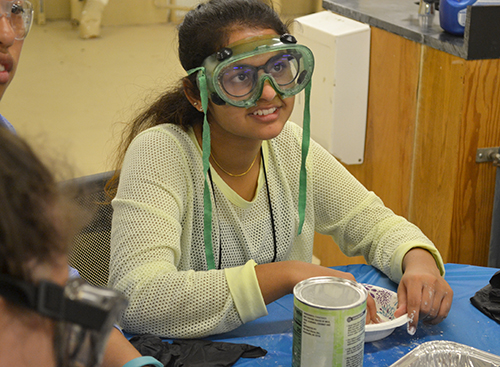 A ChBE GAMES camper works on an activity to make oobleck.
A ChBE GAMES camper works on an activity to make oobleck.The girls who took part in the camp participated in a variety of activities, including demonstrations, presentations, fun hands-on activities, and tours which exposed them to the breadth of chemical engineering. For example, they participated in six experiments led by Professor Diwakar Shukla, who is in his second year as the Director of the ChBE GAMES camp, and his lab team. The experiments involving distillation, polymer extrusion, acid rain, starch straining, foaming face wash, and continuous distillation. The campers also participated in a number of other fun experiments. For instance, the Professor Diao and his lab led the campers in activities making chocolate shapes, drying them, and discussing how chocolate crystallizes. The experiment ended, of course, as one would have hoped—the students got to eat the chocolates! In another session, Professor Mary Kraft and her team led the campers in an activity about gold nanoparticles, during which the students aggregated a gold colloid. Another popular activity was the hydrogel demonstration led by the Kong lab, wherein the hydrogels run after each other on top of water. The students also enjoyed making oobleck courtesy of the Rogers lab team.
Another activity Shukla and his group led was called computational games. This involved a software program that teaches students about proteins and how they take shape, thus showing the students a type of engineering about microscopic parts of their own bodies instead of that of a physical object. The exercise, which runs like a quiz, had the high school students input the protein structures and get scores, gradually moving on to tougher problems. Shukla believes this activity instilled confidence in the girls, saying, "It tells them that women can be computer scientists!"
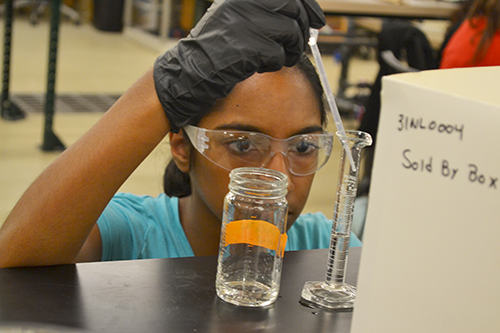 A ChBE GAMES camper pipettes during the gold nanoparticle activity.
A ChBE GAMES camper pipettes during the gold nanoparticle activity.To supplement their experience, the students toured the Abbott Power Plant near the Illinois campus, which meets 88% of the energy demand on the Urbana-Champaign campus. But Shukla, in his second year as Coordinator of the ChBE GAMES camp, was even more excited about the opportunity to take participants to see the LyondellBasell plant in Tuscola. Because it’s an actual chemical plant, the students were able to see products being manufactured, and even participated in some hands-on activities the folks there had planned. Shukla boldly states that his goal in running the camp is to increase the number of women in STEM, especially chemical engineering. He appropriately cites the reason Illinois’ Chemical and Biomolecular Engineering Department hosts the event in chemical terminology, calling it “backward integration.” The undergraduate study body in ChBE currently is at 32%, which Dr. Shukla calls “better than a lot of programs, but still not where we want it. The program is a way to attract more women to the field of chemical engineering, be they faculty, graduate students or undergraduates.”
Thus, Shukla cites his reward for organizing the event as “more diverse groups, a more diverse research community, a more accommodating academic environment.” He also has a more personal motive behind arranging the camp: his wife is also a professor in ChBE and he wants her to feel more at home in the department and the academic community at large.
 The Shukla lab team who assisted with some ChBE GAMES activities.
The Shukla lab team who assisted with some ChBE GAMES activities.Shukla leads by example in regards to increasing the number of women in his field by maintaining a gender balance in his own lab. Although most labs in the field of computation traditionally have around 20% women, his current group of students is 50% women. Plus, of the three undergrads working in his lab right now, two are women, one of whom was a TA for the GAMES camp last year and is now headed to Northwestern University for graduate school. He also has another female student joining his lab this summer. He calls his personal interactions with his female students “tremendous,” adding, “I have extremely hardworking students.”
In light of his gender equity goal, one of the major changes he sought to effect this year was having as many as possible of the lab assistants, and TAs involved be women. He reasoned that they “serve as a good role model for these high school students.” He also sought to ensure that all the female professors in the department participate this time. These includee Dr. Deborah Leckband, a Professor of Chemistry and the Reid T. Milner Professor of Chemical Sciences; Dr. Mary Kraft, an Associate Professor and Robert W. Schaefer Faculty Scholar; and Dr. Ying Diao, Assistant Professor and Dow Chemical Company Faculty Scholar. Their areas of expertise range from biology to designing solar cells and materials.
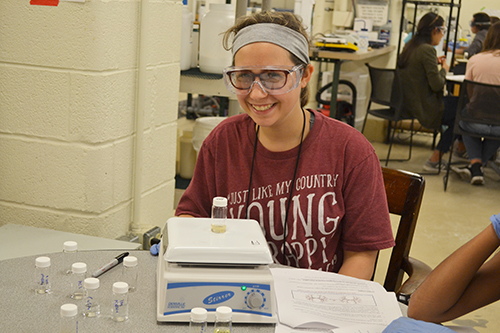 A ChBE GAMES camper completes an activity lead by the Flaherty lab group.
A ChBE GAMES camper completes an activity lead by the Flaherty lab group.ChBE’s Mary Kraft says she got involved in the camp because she believes that we need more women in engineering. She explains that the disparity in the number of female engineering students versus those who actually work as faculty leads her to feel that there is much room for improvement. Plus, she echoes Shukla’s sentiments regarding a more diverse scientific community. “We need all different points of view for solving problems,” she acknowledges. “There’s different ways of thinking about it, and having students from different backgrounds—and that includes male and female—it’s very important.”
Another goal of the camp included piquing students’ interest in science. For instance, Matthew Wade, a first-year grad student in chemical engineering, phrases a major benefit of the camp by saying, “You get to show these kids 'Hey, look! This is the sort of the stuff you can do in science!” Although these may not be the exact experiments done in labs, such as his, he feels that the activities expose the students to the “kinds of materials people in these fields look at and the type of questions they ask. It allows students to understand these materials from a scientific standpoint and translate them to an industrial perspective.”
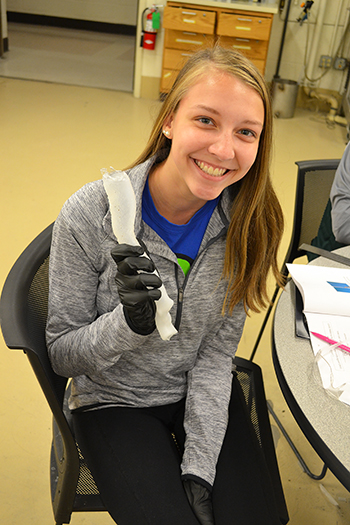 Sydney Nelso shows off the tube she made from the polymer extrusion activity.
Sydney Nelso shows off the tube she made from the polymer extrusion activity.According to ChBE postdoc Jun Park, outreach events like the camp help students differentiate between what people believe chemical engineering is and what it really is. “Most people, when they think of chemical engineering, they think about beakers and chemicals, but sometimes the things we work on in reality are the physical property of materials which is important in the industry and in our daily lives, like cosmetics or medicines.”
While the deeper-seated issues relating to the gender disparity in STEM fields cannot be completely eradicated by programs such as the GAMES camps, they prove a great first step in involving more girls in such disciplines from a younger age, which might lead to their choosing the discipline as a career. For example, Sydney Nelson, a rising junior at Tri-Valley High School, came to GAMES camp to see if she liked chemical engineering before committing four years of her college career to it. Excitedly describing the discussion during her favorite experiment, which tied in biology, she says, “We talked about how viruses can infect cells and what chemicals could be added. That’s what I’m interested in, drug manufacturing and viruses.” After experiencing the camp, Nelson seemed convinced that chemical engineering would be in her future.
 Tiffany Yen shows off the tube she made from the polymer extrusion activity.
Tiffany Yen shows off the tube she made from the polymer extrusion activity.Another participant, Kayla Epstein, a rising senior at Glenbrook North High School, came to the ChemE GAMES camp after hearing about it from a friend who had participated in it the previous year. Science and math have always been Epstein’s favorite subjects, and she credits the camp with showing her a potential career path. She now plans to apply to schools that have a strong chemical engineering program, saying, “I’m going to try and major in it.”
Another rising senior, Tiffany Yen, from Lake Zurich High School, was similarly convinced to pursue chemical engineering in college. Although she did not know what chemical engineering entailed when she first came to the camp, she now plans to make it her major and says that participating in this camp gave her the final push to make the decision. Yen had also participated in the computer science and aerospace camps over the past two years, but didn’t believe they were the right fit for her. Having taken an AP chemistry class, she actually understood what was going on in this year’s camp, which she believes played a big part in her enjoying it the most. These students demonstrate why programs such as the GAMES camps are essential in inspiring young girls to discover a love for STEM that they may not have known they had before.
Story by Niharika Roychoudhury, I-STEM undergraduate student, with Elizabeth Innes. Photos by Elizabeth Innes, Communications Specialist, I-STEM Education Initiative.
More: 8-12 Outreach, ChBE, GAMES, GAMES: ChBE, Summer Camp, Women in STEM, 2018
For additional I-STEM articles about G.A.M.E.S. camp, see:
- High School Girls Discover Chemical & Biomolecular Engineering at GAMES Camp (2017)
- Highschoolers Experience Chemical and Biomolecular Engineering at GAMES Camp (2016)
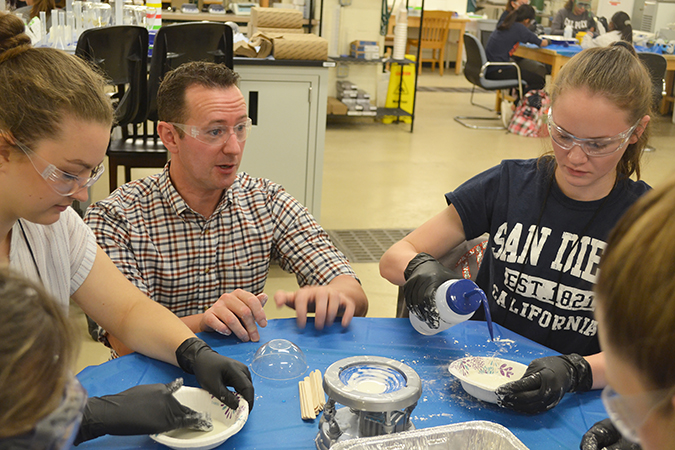 ChBE GAMES campers work on making oobleck.
ChBE GAMES campers work on making oobleck. 












.jpg)
















